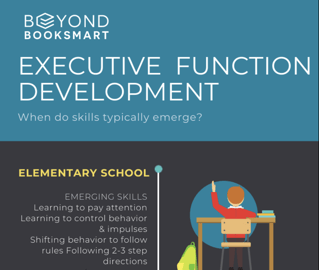Editor's Note: We are bringing back and updating our popular “Day in the Life” series that has been shared and read by thousands since they were published in 2017. We start with a glimpse into the challenges of a late elementary student and see how empathy is a useful starting point to help support them.
As an adult, you may think that being a fourth-grader is the easiest life around — no bills to pay,  no worries about your career, no responsibilities other than some homework and a couple simple household chores. But can you imagine being a fourth-grader whose everyday world of school and home feels overwhelming because they lack the Executive Function skills needed to keep focused, manage their time, and stay organized? Consider the stress that’s a daily part of the life of a fourth-grade student with Executive Function challenges in these three typical scenarios - and see some solutions that Executive Function coaches use to support students who are struggling.
no worries about your career, no responsibilities other than some homework and a couple simple household chores. But can you imagine being a fourth-grader whose everyday world of school and home feels overwhelming because they lack the Executive Function skills needed to keep focused, manage their time, and stay organized? Consider the stress that’s a daily part of the life of a fourth-grade student with Executive Function challenges in these three typical scenarios - and see some solutions that Executive Function coaches use to support students who are struggling.
Situation #1: Focusing in Class
Imagine yourself as a fourth-grader, fidget toy in hand, settling into science class after lunch. Your teacher is at the front of the class, explaining the directions for an activity. You realize about halfway through her explanation that you hadn’t really been listening, because you were distracted by the fact that your classmate was wearing the same Minecraft shirt that you have. When the other students open their notebooks and start writing, you just sit there, frozen at your desk, not knowing what to do, scared that you are about to get in trouble for not doing your work. You come home feeling worried that your teacher is annoyed with you - and more and more you start to dread the next day of school.
Some Solutions for Improving Focus
It’s never too early to talk with your child about identifying potential distractors. It can be a relief for a child to hear that we all have distractions (smartphone, anyone?) that we need to learn to manage. Starting this conversation with your child may not only reduce anxiety, but it can also help them to develop the metacognitive skills that set the stage for students to change their own behavior. Younger students need adult support as a part of the process. Ask your child if they think that sitting toward the front of the classroom could help to minimize visual distractions from classmates. If you know that your child has trouble processing or attending to verbal directions, talk with your child’s teacher about how that might manifest in a classroom. Sometimes it can help to pair verbal instructions with written ones (on the board or on a post-it note at the child's desk) to serve as reminders. Other students can benefit from a cue when careful listening is needed. For instance, teachers could help set the stage for listening by establishing eye contact with your child before giving directions.
Situation #2: Budgeting Time for Homework
You’ve been assigned a worksheet on fractions, and (sigh) you have to write an outline for a persuasive essay. You sit down to start the outline, but then you notice your cat is staring at you with those adorable big green eyes and you simply must play with her now! You go back to your outline for a while, but then you realize you are hungry and need a snack. At this rate, writing your outline is taking what seems like forever. By the time you leave for soccer practice, you’re only halfway done with the outline, and you haven’t even started on that math worksheet. You recollect the glory days of third grade when all you had to do was read for twenty minutes.
Some Solutions for Managing Time
Fourth grade is the perfect time to start using strategies for time management. It’s natural to need breaks; the trick is scheduling them ahead of time. For a fourth-grader, a good rule of thumb is to schedule a short break of 1-2 minutes after every 15 minutes of homework. Any timer will work, but Timer Tab is particularly appealing because it allows you to customize the alarm using images, sounds, and videos of your child's choice. An added benefit of using a timer to schedule breaks is that it will help a student to see how long certain tasks are taking them. Seeing that a math worksheet takes about fifteen minutes, while writing an outline takes twenty-five, enables a student to plan and prioritize by allotting a realistic amount of time for such tasks in the future.
Situation #3: Cleaning Your Room
You’ve just finished a tough week at school and now your parents are on your back (again) to get your room clean. You know where everything is, sort of. Anyway, how on earth do you even start such a massive job? It’s just too overwhelming to think about. Maybe if you distract your parents by picking a fight with your brother, they’ll forget all about this room-cleaning thing.
Some Solutions for Tackling Big Jobs
Breaking a major job into smaller steps can make it seem much less overwhelming. Instead of telling kids to “clean your room”, break it down into discrete, specific tasks, such as “today, we’ll throw the dirty clothes into the hamper and then we’ll make the bed.” By selecting just a few of the cleaning tasks to complete each day, you are modeling the skill of prioritizing. Further, by attaching time estimations to each task (“I’m betting that making the bed will take us about five minutes, tops.”), you can help your child see that cleaning one’s room is not an endlessly time-consuming job. Finally, if having a clean room is not motivation enough for your child, you can always turn it into a game. There are many apps that help kids and adults keep track of habits, but for students who enjoy video games, using the app Habitica is a motivating way to establish a few new habits and track progress on tasks that need to be done on a regular basis.
The Takeaway
The transition into late elementary school means that a lot more is required of students in terms of focusing in class, budgeting time for homework, and even taking on more responsibility at home. Students with weak Executive Functioning can experience stress and frustration when they have trouble meeting those increased demands. It’s good to know that with the right tools, strategies, and support, students can learn the Executive Function skills that are needed to thrive in their current grade and beyond.
 Download our infographic to learn what "typical" Executive Function development looks like and which skills are expected for each grade level, up to adulthood.
Download our infographic to learn what "typical" Executive Function development looks like and which skills are expected for each grade level, up to adulthood.

